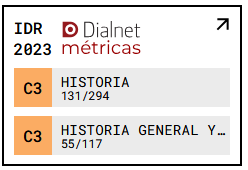Manuel Azaña as a Symbol of the Spanish Second Republic Through Satirical Press
The Case of "Gracia y Justicia" (1931-1936)
DOI:
https://doi.org/10.18172/brocar.5933Keywords:
Manuel Azaña, Spanish Second Republic, Political cartoons, XXth Century, lieu de mémoireAbstract
The relevance of Manuel Azaña (1880-1940) as one of the main public figures of 20th century Spain is unquestionable. His value as a symbol of the Second Republic includes a wide range of perspectives, from recognition and homage to satire and insult. Thus, this article offers an approach to the icon-symbolic construction of Azaña among the caricatures in the anti-Republican, far-right weekly magazine Gracia y Justicia, with the aim of demonstrating how the conceptualization of Azaña as a lieu de mémoire by anti-Republican rights had already been consolidated before the Civil War and the subsequent Francoist dictatorship.
Downloads
References
ALPERT, Michael: La reforma militar de Azaña (1931-1933), Madrid, Siglo XXI, 1982.
BORDERÍA ORTIZ, Enrique et. al. (dir.): El humor frente al poder: prensa humorística, cultura política y poderes fácticos en España (1927-1987), Madrid, Biblioteca Nueva, 2015.
CAMPOS PÉREZ, Lara: “El animalario de la Segunda República. Las metáforas zoomórficas en el humor gráfico de la prensa”, en Hispania Nova, 11 (2013).
CAPELLÁN DE MIGUEL, Gonzalo (dir.): Dibujar discursos, construir imaginarios, Santander, Editorial de la Universidad de Cantabria, 2022.
CARABIAS, Josefina: Azaña: los que le llamábamos don Manuel, Barcelona, Plaza & Janés, 1980.
EGIDO LEÓN, Ángeles (coord.): Azaña, intelectual y estadista. A los 80 años de su fallecimiento en el exilio, Madrid, Ministerio de Presidencia, Relaciones con las Cortes y Memoria Democrática/ Ministerio de Cultura y Deporte/ Acción Cultural Española, 2021.
EGIDO LEÓN, Ángeles: Manuel Azaña. Entre el mito y la leyenda, Madrid, Guillermo Escolar, 2021.
FERRER SOLÀ, Jesús: La figura intelectual de d. Manuel Azaña Díaz, Universitat de Barcelona, 1989 (Tesis Doctoral).
GARCÍA ALIX, Conrado: “La reforma militar de Azaña y su repercusión parlamentaria”, en Revista de Historia Moderna, 4 (s.d.), pp. 293-306.
GILABERT, Francisco, La Primera República Española, 1873-1874, Madrid, RIALP, 2007.
GIMÉNEZ CABALLERO, Enrique: Manuel Azaña (Profecías españolas), Madrid, Turner, 1975.
HERNÁNDEZ HERNÁNDEZ, Carlos Gregorio: Manuel Delgado Barreto (1878-1936): la pluma de un periodista al servicio de España, Madrid, Universidad CEU San Pablo, 2016 (Tesis Doctoral).
JOVER ZAMORA, José María: La era isabelina y el sexenio democrático, Barcelona, RBA, 2005.
JULIÁ, Santos: Manuel Azaña: una biografía política. Del Ateneo al Palacio Nacional, Madrid, Alianza, 1990.
JULIÁ, Santos: Vida y tiempo de Manuel Azaña (1880-1940), Madrid, Taurus, 2009
MARCO, José María: Azaña: el mito sin máscaras, Madrid, Encuentro, 2021.
MARTÍN SÁNCHEZ, María Isabel: “La caricatura política durante la II República: El Debate, El Siglo Futuro y Gracia y Justicia”, en Brocar, 34 (2010), pp. 203-242. DOI: https://doi.org/10.18172/brocar.1651
MERA COSTAS, Pilar: 18 de julio de 1936. El día que empezó la Guerra Civil, Madrid, Taurus, 2021.
MORADIELLOS, Enrique: “Ni gesta heroica ni locura trágica: nuevas perspectivas sobre la guerra civil”, en Ayer, 50 (2003), pp. 11-40.
MORADIELLOS, Enrique: 1936. Los mitos de la Guerra Civil, Barcelona, Península, 2004.
MOVELLÁN HARO, Jesús: “Piedra, papel, memoria. La memoria colectiva en la historia a través del análisis icono-simbólico de los imaginarios colectivos: una propuesta teórica”, en Cuadernos de Historia Contemporánea, 45 (2023), pp. 377-404. DOI: https://doi.org/10.5209/chco.84807
MUELA MARTÍN-BUITRAGO, Manuel y TORRES GALLEGO, Emilio: Azaña, estadista: un proyecto de Estado vigente, Madrid, Nuestra Cultura, 1983.
NORA, Pierre: Les lieux de mémoire (trois volumes), Paris, Gallimard, 1997.
OROBON, Marie-Angèle y LAFUENTE, Eva (Coords.): Hablar a los ojos. Caricatura y vida política en España (1830-1918). Zaragoza, Prensas de la Universidad de Zaragoza, 2021.
ORTEGA ÁLVAREZ, Luis (coord.): Las reformas administrativas en la II República, Madrid, Instituto Nacional de la Administración Pública, 2009.
PEÑA GONZÁLEZ, José: Gracia y Justicia o el humor político de la derecha española durante la II República, Madrid, ACdP/CEU Ediciones, 2016.
PEÑA GONZÁLEZ, José: El único estadista. Una visión satírico-burlesca de don Manuel Azaña, Madrid, Fundamentos, 2007.
PIQUERAS ARENAS, José Antonio: La revolución democrática (1868-1874): cuestión social, colonialismo y grupos de presión, Madrid, Ministerio de Trabajo y Seguridad Social, 1992.
REICHARDT, Rolf: “La guerra di caricature pro e contro Napoleone Bonaparte: una cultura della derisione politica su scala europea”, en Memoria e ricerca, 69 (2022), pp. 9-32.
REIG TAPIA, Alberto: La cruzada de 1936: mito y memoria, Madrid, Alianza, 2006.
RIVAS CHERIF, Cipriano: Retrato de un desconocido: vida de Manuel Azaña, Barcelona, Grijalbo, 1980.
RODRÍGUEZ HOZ, Rebeca: ¿Qué fue de la niña bonita? La experiencia republicana en la narrativa (1937-2021), Madrid, Genueve Ediciones, 2023. DOI: https://doi.org/10.22429/Euc2023.027
ROLDÁN CAÑIZARES, Enrique: “Las reformas militares durante la II República: un asunto político”, en Revista Internacional de Pensamiento Político, I Época, 11 (2016), pp. 403-419.
SERRANO GARCÍA, Rafael, Figuras de “La Gloriosa”: aproximación biográfica al sexenio democrático, Valladolid, Universidad de Valladolid, 2006.
SUÁREZ CORTINA, Manuel: Galdós y la novela histórica: el Sexenio Democrático (1868-1874) en los Episodios Nacionales, Santander, Universidad de Cantabria, 2020. DOI: https://doi.org/10.22429/Euc2021.018
VEGA, Jesusa: “La cambiante imagen de Napoleón en España: del retrato imperial a la bestia apocalíptica y su desmemoria”, en Ars longa: cuadernos de arte, 27 (2018), pp. 183-193. DOI: https://doi.org/10.7203/arslonga.27.12261
VIGIL, Alicia, EGIDO LEÓN, Ángeles y MANCEBO ALONSO, María Fernanda (coords.): Manuel Azaña: Pensamiento y acción, Madrid, Alianza, 1996.
YOUNG, James E.: The Texture of Memory. Holocaust Memorials and Meaning, New Haven, Yale University Press, 1993.
Downloads
Published
How to Cite
Issue
Section
License
Copyright (c) 2025 Jesús Movellán Haro

This work is licensed under a Creative Commons Attribution 4.0 International License.
The authors retain copyright of articles and authorize CIF the first publication. They are free to share and redistribute the article without obtaining permission from the publisher as long as they give appropriate credit to the editor and the journal.
Self-archiving is allowed too. In fact, it is recommendable to deposit a PDF version of the paper in academic and/or institutional repositories.
It is recommended to include the DOI number.
This journal is licensed under a Creative Commons Attribution 4.0 International License











